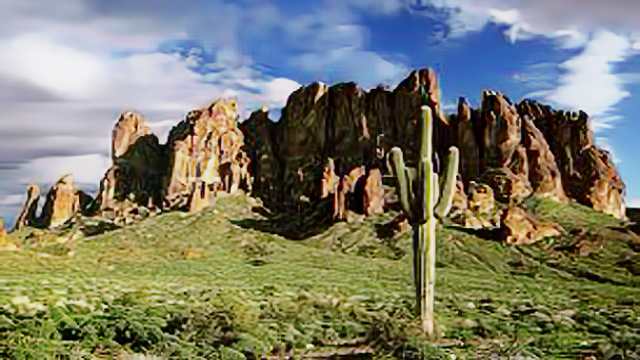Just east of Phoenix, Arizona lies a rugged and mysterious region where people sometimes venture only to disappear without a trace. This enigmatic place, known as Superstition Mountain, is steeped in legend and lore, with tales of a hidden gold mine that has captured the imagination of many adventurers and claimed the lives of countless others. The “Lost Dutchman Mine,” as it is famously called, is said to hold a fortune in gold, but its exact location remains a tantalizing mystery.
Table of contents
The Enigma of Superstition Mountain
Superstition Mountain is not a single peak but a collection of rough terrain that includes cliffs, peaks, plateaus, and mesas. Despite being referred to as a mountain range, it is technically only one mountain. This region has a notorious reputation for being deadly, having claimed the lives of numerous men and women over the centuries. The Apache Indians were among the first to encounter the mountain, followed by Spanish conquistadors like Francisco Vasquez de Coronado, who sought the legendary “Seven Golden Cities of Cibola” in 1540.
The local Apache tribes warned Coronado of the mountain’s dangers, believing that the “Thunder God” protected its gold and would destroy any trespassers. Despite these warnings, the Spaniards attempted to explore the mountain, only to have men mysteriously vanish or be found mutilated, their heads severed. These terrifying events led Coronado to name the collection of peaks “Monte Superstition,” marking the beginning of the mountain’s dark legend.
The Spanish Mine and the Peralta Tragedy
In 1845, Don Miguel Peralta, a member of a prominent Mexican family, discovered a rich vein of gold on Superstition Mountain while searching for the treasure described to Coronado. Peralta named the mine “Sombrero Mine” after a distinctive peak that resembled a sombrero. He returned to Mexico to gather men and supplies, intending to excavate the gold. However, the Apache were angered by the Spanish presence and raised a large force to drive Peralta and his men away. In 1848, Peralta and his men were ambushed and massacred by the Apache, leaving the mine’s location hidden and the gold scattered.
The Blindfolded Doctor’s Tale
Dr. Abraham Thorne, an army doctor at Fort McDowell, became another key figure in the legend of the Lost Dutchman Mine. In 1870, Thorne was blindfolded and led by Apache elders to a canyon where he found a stack of almost pure gold nuggets. The Apache elders, respecting Thorne’s goodwill towards their people, revealed this secret location to him. Thorne later sold the gold for $6,000, adding another layer of mystery to the mine’s location.
The Dutchman and His Hidden Treasure
Jacob Walz, a German immigrant mistakenly called the “Dutchman,” became the most famous figure associated with the Lost Dutchman Mine. After years of prospecting, Walz and his partner, Jacob Weiser, allegedly discovered the mine’s location. Some stories claim they found it accidentally, while others suggest they were given a map by a Mexican don whose life they saved. Regardless of how they found it, the two men frequently appeared in Phoenix with gold nuggets, fueling speculation about the mine’s existence.
Walz was known for giving contradictory directions to the mine, and many men tried to follow him only to lose his trail. Upon his death in 1891, Walz left behind a sack of rich gold ore but no clear clues to the mine’s location. His death sparked a century of searches, with many adventurers disappearing or meeting mysterious ends in the pursuit of the elusive treasure.
The Haunting Legacy of Death and Disappearance
The quest for the Lost Dutchman Mine has claimed many lives. Some who disappeared may have quietly slipped away, unwilling to admit failure, while others met mysterious and violent ends. The death toll includes the legendary Peralta Massacre, murders attributed to Jacob Walz, and numerous victims of Apache attacks.
One notable case is that of Adolph Ruth, who vanished in 1931 while searching for the mine with an old Peralta map. His skull was later found with bullet holes, but the cause of his death remains a mystery. Similarly, the bodies of soldiers, prospectors, and adventurers have been found decapitated, shot, or simply vanished, leaving their fate unknown.
Modern-Day Searches and Precautions
The allure of the Lost Dutchman Mine continues to draw treasure hunters and adventurers. However, the harsh and dangerous terrain of Superstition Mountain demands caution. Experts advise against relying on maps claiming to show the mine’s location, recommending instead to explore in pairs, carry plenty of water, and go armed for self-defense. Establishing a central camp and working in all directions from it can also increase safety.
The Eternal Mystery
Superstition Mountain and the Lost Dutchman Mine remain one of Arizona’s most enduring mysteries. The tales of lost gold, supernatural guardians, and unexplained deaths continue to captivate the imagination. Whether the mine truly exists or is merely a legend, the stories of those who sought its treasure and met untimely ends serve as a haunting reminder of the perils that lie hidden in the rugged wilderness of Superstition Mountain.

